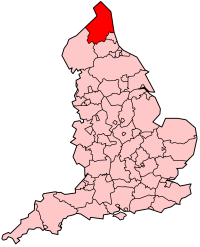Lindisfarne is a tidal island off Northumberland, England.
Contents
Lindisfarne may also refer to:
Lindisfarne is a tidal island off Northumberland, England.
Lindisfarne may also refer to:

Lindisfarne, also called Holy Island, and the Holy Island of Lindisfarne, is a tidal island off the northeast coast of England, which constitutes the civil parish of Holy Island in Northumberland. Holy Island has a recorded history from the 6th century AD; it was an important centre of Celtic Christianity under Saints Aidan, Cuthbert, Eadfrith, and Eadberht of Lindisfarne. The island was originally home to a monastery, which was destroyed during the Viking invasions but re-established as a priory following the Norman Conquest of England. Other notable sites built on the island are St. Mary the Virgin parish church, Lindisfarne Castle, several lighthouses and other navigational markers, and a complex network of lime kilns. In the present day, the island is an Area of Outstanding Natural Beauty and a hotspot for historical tourism and bird watching. As of February 2020, the island had three pubs, a hotel and a post office.
Riverside may refer to:
Acton may refer to:

Northumberland is a ceremonial county in North East England, bordering Scotland. It is bordered by the Scottish Borders to the north, the North Sea to the east, Tyne and Wear and County Durham to the south, and Cumbria to the west. The town of Blyth is the largest settlement.
West Coast or west coast may refer to:
A hunter is a person who hunts.
Merton may refer to:

Northumberland, England's northernmost county, is a land where Roman occupiers once guarded a walled frontier, Anglian invaders fought with Celtic natives, and Norman lords built castles to suppress rebellion and defend a contested border with Scotland. The present-day county is a vestige of an independent kingdom that once stretched from Edinburgh to the Humber, hence its name, meaning literally 'north of the Humber'. Reflecting its tumultuous past, Northumberland has more castles than any other county in England, and the greatest number of recognised battle sites. Once an economically important region that supplied much of the coal that powered the industrial revolution, Northumberland is now a primarily rural county with a small and gradually shrinking population.

Lindisfarne is a suburb of Hobart's Eastern Shore, located approximately 6 kilometres from the City Centre and is part of the municipal City of Clarence.

Lindisfarne Castle is a 16th-century castle located on Holy Island, near Berwick-upon-Tweed, Northumberland, England, much altered by Sir Edwin Lutyens in 1901. The island is accessible from the mainland at low tide by means of a causeway.
Murton could refer to:
This timeline summarises significant events in the history of Northumbria and Northumberland.

Henry Oscar Murton, Baron Murton of Lindisfarne was a British Conservative Party politician.

The bishop of Durham is responsible for the diocese of Durham in the province of York. The diocese is one of the oldest in England and its bishop is a member of the House of Lords. Paul Butler has been the bishop of Durham since his election was confirmed at York Minster on 20 January 2014. The previous bishop was Justin Welby, now archbishop of Canterbury.
Night is the period in which the sun is below the horizon.
Gordon may refer to:

Back and Fourth is a 1978 album by English rock band Lindisfarne. Released in nine countries on three record labels, it reached position 22 on the UK album charts and contained the successful single "Run for Home".

Lancelot Errington, also Launcelot or Lancelott, (1657–1745) was a master mariner noted for his capture of Lindisfarne during the Jacobite rising of 1715.

Holy Island War Memorial, or Lindisfarne War Memorial, is a First World War memorial on the tidal island of Lindisfarne off the coast of Northumberland in the far north east of England. Designed by Sir Edwin Lutyens, the memorial is a grade II* listed building.